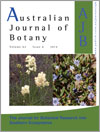Australian Journal of Botany
Volume 62
Number 6 2014
Determining the breeding systems and reproductive success in closely related rare and common species may shed light on factors influencing rarity. We investigated the breeding systems and measured fecundity in the Davidsonia genus and found that polyembryony and likely apomixis may confer an advantage to the widespread species despite having lower fecundity than the endangered, selfing species. This study contributes to our knowledge on rare–common differences in rainforest species and provides novel information regarding breeding systems in the Cunoniaceae family.
The role of smoke in promoting seed germination is complex, with several chemicals identified as promoting or inhibiting germination of different species. We tested whether the smoke derived from an introduced grass promoted the same germination density as smoke from a native grass. The test species, a native lemon grass, showed smoke-enhanced germination, the first for a species of Cymbopogon, but its density of germination did not differ between smoke from the introduced buffel grass and that from native spinifex grass.
Seasonal herbaceous wetlands are listed as critically endangered in Australia. This study describes their water regime and the plants that grow in them: i.e. the factors that make them ‘swampy’. As the climate dries we will need to understand what they need to function, so we can conserve them as habitats for frogs, birds and plants.
Declining rainfall will heavily affect seed germination in many species in seasonal Mediterranean climates. Seeds of four Western Australia Banksia species were exposed to moisture-stress conditions during incubation, with results demonstrating how vulnerability to moisture stress varies across species and populations. Identifying drought tolerance during early developmental stages in a plant’s life cycle is vital for conserving species in situ and for effective restoration in a warming, drying world.
Energy efficient plant species is the prerequisite for managing arid waste lands. Attributes related with different forms of energy (radiant to biological) were quantified for Corchorus depressus. Study revealed many interconnected relationships among energy, respiration, productivity, growth and community variables. Efficient energy and high reproductive traits of this species assert it appropriateness to manage arid wastelands.
The vegetation patterns in lentic subtropical wetlands relate to water depth and slope. The flora is widespread and mostly has affinities with the tropics. The exotic mat-forming herb lippia (Phyla canescens) is present in the wetlands of the upper Dawson River but is not rampant and there are no exotic ponded pasture grasses that are widespread in tropical wetlands.
The morphology and anatomy structures and seed germination of two Conospermum species were examined. The results show that the infructescence protects the fruits from heat up to 200°C for both species. C. capitatum requires either heat or smoke to cue germination, whereas C. petiolare requires no cue. A combination of structure modification and germination requirements may be needed to develop serotiny from non-serotinous antecedents.
The persistence of fern spores in arid and fire-prone environments is poorly understood. Examining survival and germination of Cheilanthes spp. spores from semi-arid Western Australia, we found spores can survive to ~15 years, temperatures of −2°C to 100°C and buried >5 cm, but germinate only in light. In a unique strategy, spore persistence is occurs solely by burial and germination by exhumation.
Data about interactions between carnivorous plant Utricularia and algae concern mostly the aquatic species that are characterised by similar trap construction. The composition of the trap prey and phytotelmata of the affixed aquatic Utricularia volubilis, a species that does not have trigger bristles, were examined and differences in the composition of various algal groups from the communities inside the traps were observed. The type of trigger mechanism has minor influence to the composition of the trapped algae.




